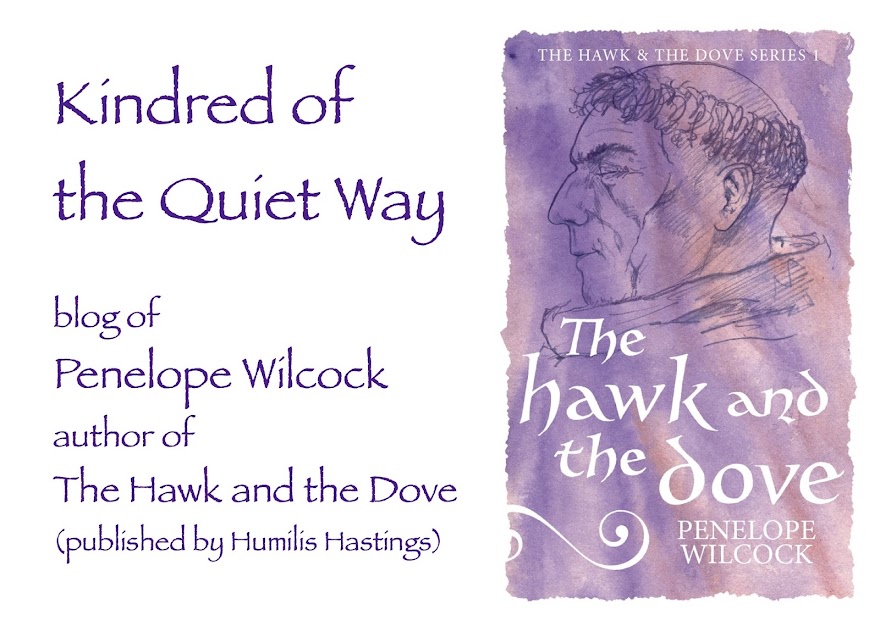We have an engawa and we didn't even know it.
Japanese life and culture speaks to my soul, and I enjoy watching YouTube videos on that very subject, and recently I settled down to one all about traditional Japanese homes.
I discovered that they typically have what is called an 'engawa' — which is a small courtyard with moss or low-growing plants, a brazier to make a cup of tea or something outside, a cherry tree, and a spiritual statue.
And I thought — oh, my goodness — that's exactly what we have!
Our house, like most Victorian homes, is L-shaped, creating a little courtyard. There we have our water butts and our wood store — but also a buddha under a small flowering cherry tree, and a patch that used to be for growing vegetables but (after our plot beans blew down in the storm and our potatoes and tomatoes grew so huge and jungly that it was impossible to edge round the patch) then a year ago I planted it with lawn camomile and lawn mint and low-growing thyme and mossy plants. The plants established beautifully, and it looked so pretty.
Here's the buddha from our engawa, in the spring, under his flowering cherry.
I wanted a Jizo statue like the one they have in the moss garden at the Sanzen-in temple in Kyoto.
Jizo, meaning "womb of the earth", or "earth bearer", represent Jizo Bosatsu, a Japanese guardian deity going right back to pre-Buddhist days — for the protection of children and travellers. They are always made of stone, the material that represents the Earth, and are often placed as memorials for children who have died or are stillborn. They are always in the form of a monk in simple robes, a bodhisattva whose vow is not to leave Earth for Nirvana until all the hells are empty. Rather like the archangel Rafael who travels with us, our companion on the journey and our divine protector.
Here is the one I put in our engawa.
Lovely, eh?
But, can you see little holes among the plants? Badgers did that, digging for worms.
They came back. Night after night.
They trashed the plants. They dug holes everywhere.
I replanted everything, but they came back, every night, digging for beetles and worms.
They trashed it absolutely and completely, digging up the little stones and tossing the plants everywhere.
So we got more, bigger, stones. Today we (Alice and Hebe mainly) put them in. This is what it looks like now.
I think I'll wait and see what the morning brings before I put the Jizo statue back, because I don't want it to get broken.









5 comments:
I hope you can find a solution to keep your chaos-badgers at bay. Also, I've been looking for some youtube videos like you describe. If you have suggestions, I'd love to hear!
Oh, there are loads! If you do a Google search on "YouTube Japanese traditional home" or "YouTube Japanese lifestyle" or just go straight to YouTube and search on "Traditional Japanese house" or "Japanese culture" or "Shinto" . . . Even if you're not keen on the first ones it turns up, there'll be a whole string of options in the side-bar, and you'll soon find your way to a channel you like. x
Many thanks! Sounds like a perfect way to spend a fall evening or two...or 20. :-)
I am so sorry you have had drama with badgers and the garden. I have always wanted to have a herb type turf. Sadly I think the climate is too harsh. God bless.
Bethany — yes. There's something disciplined and quiet about the Japanese approach to life, with a feeling for all that is humble and plain and well-worn and natural, and a sense of our responsibility to one another in community, that speaks peace to my soul.
Suzan — I was really upset about it, I can tell you!! But I think — we need a few more stones still — once it's finished and the little plants are growing between the stones and spilling over onto them, it'll look nice again. And yes, I can see it wouldn't last five minutes in Australia!
Post a Comment